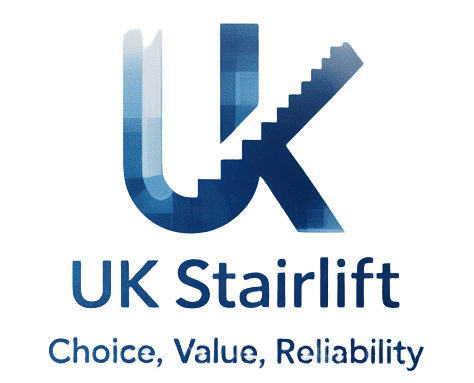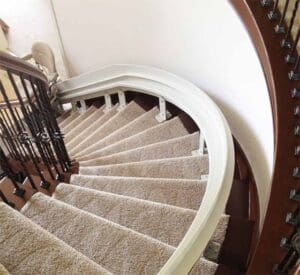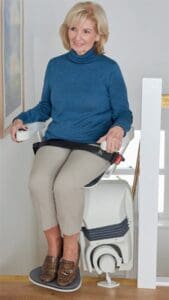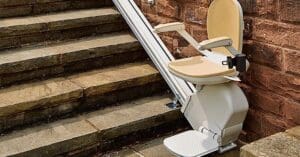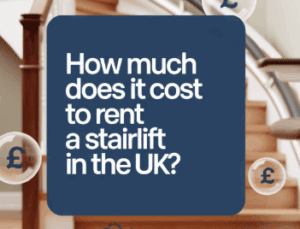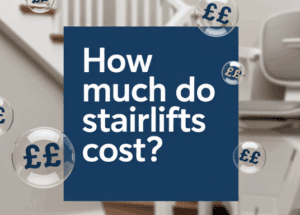Here’s what nobody tells you upfront: a straight stairlift costs around £2,500 installed.
Not “from £995” like some ads suggest. Not “it depends” without giving you actual numbers. Most people in the UK with a standard staircase pay between £2,250 and £2,750, all in.
Quick Answer: Expect £2,500 for a typical 13-step straight staircase. The stairlift price includes the unit, rail, fitting, and someone showing you how to use it. New models start at £1,975 while premium options reach £3,500.
Now let’s talk about what actually affects that number, because your stairs aren’t exactly like everyone else’s.
What Changes Your Straight Stairlift Cost
Stair length matters more than anything else. Every extra metre of rail costs money because there’s more material and more time to install it. A 10-step staircase costs less than a 16-step one. Simple as that.
Then there’s new versus reconditioned. A brand new Acorn or Stannah runs about £2,750. A reconditioned stairlift starts around £1,500. That’s a genuine £1,250 difference.
Brand choice shifts the stairlift price too, but honestly not by much. The major stairlift companies all cluster around the same price point because they’re competing for the same customers.
What You Actually Get for £2,500
When an installer quotes £2,500, here’s what should be included:
- A new stairlift (factory fresh, not refurbished)
- An engineer fitting it at your home in 2-4 hours
- Two year warranty covering parts and labour
- Standard straight rail that bolts to your stairs
- Testing everything thoroughly and showing you the controls
If any of those are missing or cost extra, ask why.
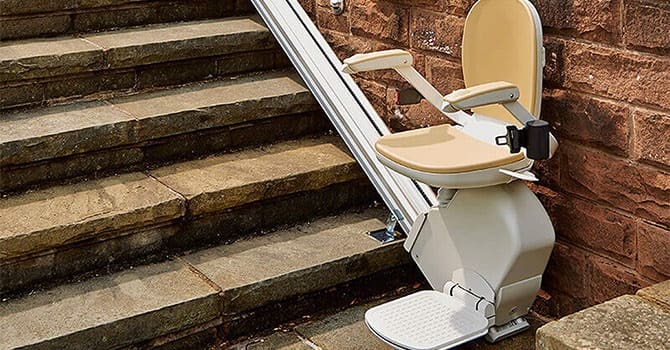
Comparing Straight Stairlift Prices by Brand
| Brand | Model | Starting Price | Warranty |
|---|---|---|---|
| Acorn | 130 Straight | £2,750 | 2 years |
| Stannah | 260/300 Series | £2,700 | 2 years |
| Companion | 1000/1100 | £2,650 | 2 years |
Acorn stairlifts and Stannah stairlifts dominate the UK market. The prices are similar because the products are similar. All three are reliable. All three have engineers across the UK. All three will last 10-15 years if you maintain them properly.
The real difference shows up in how quickly they respond when something goes wrong, and that varies by your postcode more than the brand name.
How Stairlift Installation Actually Works
An engineer arrives at your house with the rail and chair in a van.
They spend 2-4 hours:
- Bolting the rail to your stair treads (it goes on the stairs, not the wall)
- Clicking the chair unit onto the rail
- Running it up and down multiple times to check it’s smooth
- Showing you how to use the controls and safety features
You can use your stairlift installed the same day. No plastering, no painting, no mess beyond a few drill holes in your stairs.
The rail stays on one side of your staircase. Other people can still use the stairs normally because the chair folds up when you’re not using it.
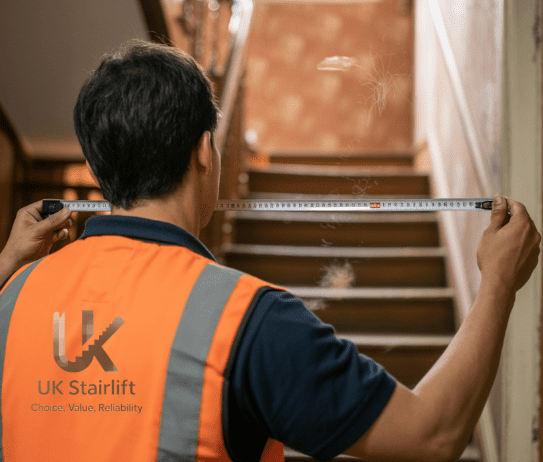
The Extras That Add to the Cost of a Stairlift
Warranty extensions add about £250 per year after your initial two years run out. Buy three or five years upfront and it works out cheaper per year, usually around £200 annually.
Perch seats (also called standing stairlifts) cost extra because they’re engineered differently. If you can’t bend your knees to sit down properly, this type of stairlift lets you lean back while standing. Essential for some people with mobility issues, pointless for others.
Remote controls at both ends of the stairs run £100-200 more. Useful if two people share the stairlift because you can call it from upstairs or downstairs.
Powered hinges solve a specific problem. If you have a door at the bottom of your stairs that would hit the rail, a powered hinge lifts part of the rail up when the chair parks. That’s another £500 or so, but it’s cheaper than moving the door.
Get a free stairlift assessment to see what your actual stairs need. No point guessing when someone can measure and tell you exactly.
Running Costs Are Nearly Nothing
Your stairlift will cost about £12 a year in electricity. That’s how little it costs to run a stairlift.
That’s based on using it four times a day, every single day. Each trip uses 0.024kWh. Over a year that’s 35kWh total, which costs roughly £12 at UK 2025 energy prices.
For context, your kettle probably costs more.
Maintenance is the bigger ongoing cost. Annual servicing runs about £250 if you’re paying separately. Most new stairlifts include this for the first two years, then you either pay per year or buy an extended warranty.
The VAT Exemption You Should Know About
You don’t pay VAT on stairlifts if you’re chronically sick or disabled.
That’s 20% off immediately. On a £2,500 stair lift, you save £500 just by claiming the exemption.
The definition of “chronically sick” is broader than you think. It includes:
- Any physical condition affecting your mobility and daily life long-term
- Arthritis, diabetes, heart conditions, breathing problems
- Mental health conditions that affect mobility or daily activities
- Basically anything a doctor would call a chronic condition
This comes from HMRC Notice 701/7. Reputable stairlift providers know about it and won’t charge you VAT if you qualify. If they try to charge VAT anyway, question it.
How to Pay Less When Buying a Stairlift
Buy a reconditioned straight stairlift if the warranty doesn’t scare you. Reconditioned stairlift options start at £1,500 versus £2,750 for new. They’re used stairlifts that have been checked, serviced, and given a one-year warranty.
The gamble? Parts wear out. A reconditioned model might need stairlift repairs in year two or three. A new straight stairlift probably won’t need anything for five years.
Actually get three quotes and compare prices. I know everyone says this, but most people don’t do it. Different stairlift companies mark up differently. Same brand, same stairlift model, £400 difference between quotes. That’s real money.
Ask what’s included. Some quotes bundle warranty and maintenance. Others add it later as an upsell. Make sure you’re comparing identical packages.
Buy in January or February. Demand drops after Christmas. Some installers offer better stairlift prices to fill their schedule.
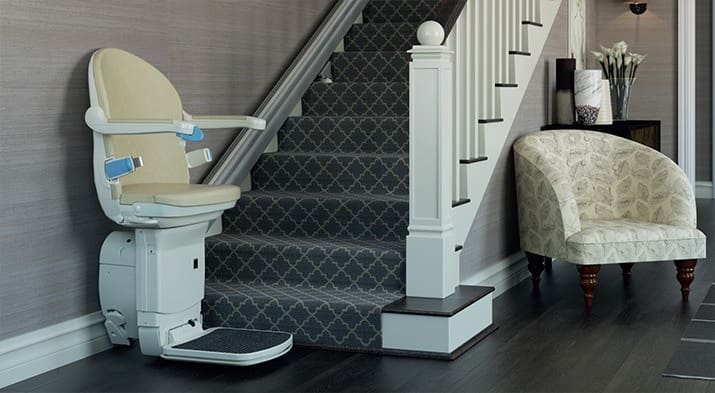
New Straight Stairlift vs Reconditioned Stairlift
A new straight stairlift costs more because you get:
- Longer warranties (two to five years instead of one)
- Latest stairlift technology and safety sensors
- No worn parts from someone else’s use
- Better resale value if you sell your house
Reconditioned stairlift prices are lower because:
- Lower upfront cost (£1,500 versus £2,750)
- One-year warranty still included
- Same safety standards legally required
- Sometimes faster availability
Most people pick new. The extra £1,250 buys peace of mind that it won’t break down when you need it most.
But if money is genuinely tight, a reconditioned straight stairlift makes sense. Just budget for potential repairs after year one.
Why Straight Stairlifts Cost Less Than Curved Stairlifts
The average cost of a stairlift depends heavily on whether you need a straight or curved model.
| Feature | Straight | Curved |
|---|---|---|
| Average Cost | £2,500 | £5,500 |
| Rail Type | Standard length | Custom-made for your stairs |
| Installation Time | 2-4 hours | 6-8 hours |
| Resale Value | £300-500 | Almost nothing |
Curved stairlift prices are higher because the rail gets manufactured specifically for your staircase. Every turn, every curve, every angle, every measurement is custom. That manufacturing time costs serious money.
Straight models come in standard lengths. The installer cuts the straight rail to fit your stairs on site. Much faster, much cheaper.
If your stairs go straight up with no turns or landings, you’ve already saved yourself £3,000 compared to someone with curved staircases. That’s why understanding whether you have straight stairs or a curved stair matters so much when budgeting.
Stairlift Options Worth Paying For (and Ones That Aren’t)
When comparing stairlift models, focus on what actually matters:
Worth it:
- Swivel seat (usually standard anyway, lets you get off safely at the top)
- Safety sensors that stop if something’s in the way (every stairlift should have these)
- Folding footrest and armrests (makes the chair narrower when not in use)
Worth it for some people:
- Standing stairlift design if you genuinely cannot sit down
- Remote controls if multiple stairlift users share the equipment
- Powered hinge if a door would hit the rail
Probably not worth it:
- Fancy upholstery colours (you’re the only one who sees it)
- Extended rails that go way past the top step (usually unnecessary)
- Digital displays showing floor levels (you know which floor you’re on)
Stairlift Rental vs Buying: When Each Makes Sense
Rental costs about £15 per week for straight stairlifts. That’s £780 per year. Plus installation runs around £450 upfront.
Year one total: £1,230 Year two total: £2,010 Year three total: £2,790
See the problem? By year three you’ve paid more than the cost of stairlift ownership would have been, and you own nothing.
Renting makes sense if:
- You need it for under 18 months (post-surgery recovery, temporary mobility issue)
- You’re unsure about staying in your home long-term
- You want to try before committing
Buying makes sense if:
- You’re planning to stay in your home for years
- You need it indefinitely for ongoing mobility challenges
- You want to spread payments rather than pay weekly
Straight Stairlift Cost Versus Moving House
Moving house in the UK costs £14,000 to £20,000 on average.
That includes stamp duty, estate agent fees, conveyancing, surveys, and actually moving your stuff. It doesn’t include the emotional cost of leaving your neighbourhood, your neighbours, your local shops.
A £2,500 stair lift cost suddenly looks reasonable.
You stay in your home. Your GP stays your GP. Your friends stay close. Everything you know stays familiar. And you’ve spent a fraction of what moving would have cost.
Plenty of people convince themselves they “should” move because stairs have become difficult. But adapting your home is almost always cheaper and less disruptive than relocating.
The demand for stairlifts continues to climb. In fact, industry data shows the UK stairlift market is expected to grow nearly 80% by 2030 . That steady demand helps explain why prices remain consistent yet competitive in 2025. source
What Happens to the Value When You Need Stairlift Removal
Straight stairlifts hold some resale value. Not much, but some.
Expect £300-500 if you’re selling a newer Acorn or Stannah in good condition. Older models or lesser-known brands might get £200. Second-hand stairlifts cost less than you’d hope, but straight stairlifts are easier to resell than curved models.
Most people leave their current stairlift in place when they sell their house. It can actually help sell the property because it shows buyers that someone’s already solved the stairs problem. Older buyers see that as a bonus, not a negative.
If you need professional stairlift removal, expect to pay £150-300 unless your installer includes it in a replacement package.
Costs Nobody Mentions Until You Ask
Initial surveys are usually free, but some companies charge. Ask before booking.
Removing an existing stairlift if you’re replacing one can cost extra. Some installers include it, others charge separately.
Electrical work is rarely needed because stairlifts come with standard plugs for normal outlets. But occasionally someone needs an electrician to add a socket near the stairs. That’s your cost, not the installer’s.
Building modifications like narrow walls or tight corners sometimes need work. Unusual but possible. The home assessment should flag this before you commit.
Maintenance You Should Actually Do
Annual servicing costs £250 if you’re paying as you go.
Most people buy maintenance contracts instead:
- Yearly safety inspection
- Stairlift repairs covered
- Replacement parts included
- Emergency callouts with quick response
New stairlifts usually include this for the first two years. After that you either pay per year (£250) or buy longer cover upfront (£200 per year for 3-5 year plans).
Is maintenance optional? Technically yes. Practically no. A stairlift is a mechanical device that carries you up stairs. Get it serviced yearly.
Finding the Best Stairlift for Your Needs
Whether you need a straight stairlift or a curved stairlift depends entirely on your stairs. A straight flight of stairs means you can choose from a range of straight stairlifts that cost significantly less than custom curved options.
Straight stairlifts are designed for stairs with no turns, no landings, and no curves. If your stairs meet this description, you’re looking at the lower stairlift cost range we’ve been discussing.
The best stairlift for you balances cost, features, and reliability. Don’t assume the cheapest quote gives you the best stairlift prices. Look at the complete package.
Are There Stairlift Grants Available?
Some local councils offer stairlift grants through Disabled Facilities Grants. These are means-tested and can provide up to £30,000 for home adaptations, though most grants are smaller.
Requirements vary by location. Contact your local council’s adult social care department to ask about funding options. Even if you don’t qualify for a grant, the VAT exemption still saves you 20%.
Getting the Best Stairlift Prices in the UK
Call three different stairlift providers. Seriously, actually do this.
When you call, ask:
- What’s included in your straight stairlift prices quote?
- What’s not included? (Any extra costs for my specific stairs?)
- What warranties do stairlift companies offer and what do they cover?
- How quickly do you respond to repair callouts?
- Can I see the range of stairlift options before deciding?
Then compare identical packages. A £2,400 quote with one-year warranty isn’t better than a £2,600 quote with three-year warranty and servicing included.
The cost depends on your specific needs. Prices vary between providers. Get quotes from the top stairlift companies to find stairlifts at affordable prices that actually deliver value.
Understanding What Different Stairlift Types Cost
The stairlift type you need dramatically affects cost:
Straight stairlifts (£2,500 average) work for stairs with no turns. These represent the best value because they use standard components.
Curved stairlifts (£5,500 average) are custom-built for stairs with turns or curves. The cost of the stairlift increases because of manufacturing complexity.
Standing stairlifts (£2,800+ average) work for people who can’t sit down. Slightly more than standard seated models.
Outdoor stairlifts (£3,350+ average) are weatherproofed for external stairs. The stairlift will cost more because of weather-resistant materials.
A straight stairlift for a standard 13-step staircase remains the most economical choice.
How Much Does a Stairlift Cost: The Bottom Line
Much does a stairlift cost? For straight stairs, expect £2,500 for most UK homes.
You’ll pay less if you buy reconditioned, have short stairs, or get multiple competitive quotes. You’ll pay more if you want premium brands, need special features, or have a very long staircase.
The average cost of a stairlift in 2025 reflects quality, safety, and reliability. Whether you choose a brand-new stairlift or reconditioned option, you’re still spending a fraction of what moving house would cost.
Most UK stairlift experts agree: adapting your home makes more sense than relocating. The 2025 stairlift prices we’ve discussed represent genuine value compared to the alternatives.
Book a free home assessment. They’ll measure your stairs, show you the range of stairlift options available, and give you an accurate quote. No guessing, no “it depends,” just real numbers for your actual situation.
That’s when you’ll know exactly how much your straight stairlift will cost.
Common Questions About Straight Stairlift Costs
What is the average straight stairlift cost in 2025?
The average straight stairlift costs £2,500 including installation in 2025. Most people pay between £2,250 and £2,750 for a standard 13-step staircase. Reconditioned straight stairlift options start at £1,975 while premium new straight models with extended warranties reach £3,500. Stairlift prices in the UK vary by brand and features.
Do straight stairlifts include installation in the price?
Yes, reputable quotes include installation. You should get the stairlift unit, rail, professional fitting, safety testing, and a demonstration. The stairlift will cost the same whether fitted left or right. If installation is listed separately, ask why before agreeing to anything with stairlift manufacturers.
How much does a reconditioned straight stairlift cost?
Reconditioned stairlift prices range from £1,500 to £2,000. They come with a one-year warranty and meet all safety standards. A new straight stairlift costs £2,500-£3,500 but includes longer warranties and no worn parts from previous use. Cost of stair lift ownership is lower with reconditioned models upfront.
What’s the cost difference between straight and curved stairlifts?
A straight or curved model decision makes a huge price difference. Straight stairlifts cost around £2,500 while curved stairlifts cost approximately £5,500. Curved stairlift prices are higher because they need custom-made rails for your specific staircase. Straight stairlifts cost less because they use standard rails.
